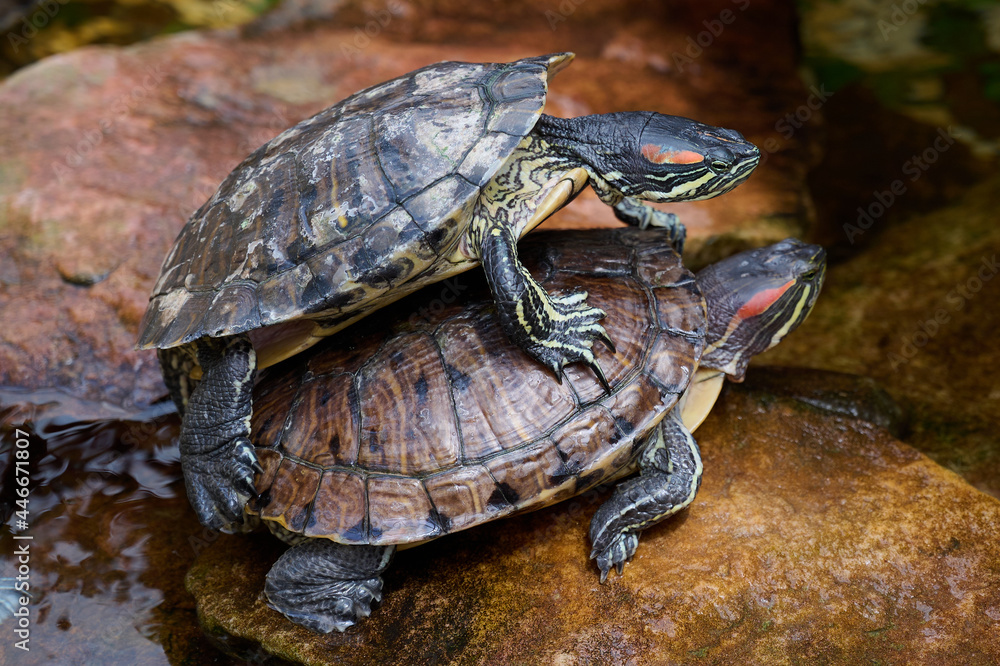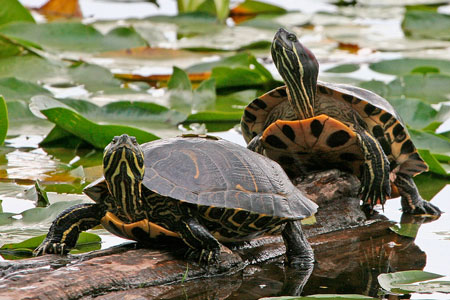Red-eared slider turtles mate through a process called copulation, where the male mounts the female. This allows the male to transfer sperm to the female for fertilization.
During mating season, which typically occurs in spring and early summer, male turtles will actively pursue female turtles for mating opportunities. The courtship behavior involves the male swimming around the female, nudging her shell, and attempting to mount her. Once successful, copulation takes place in the water, with the male using his long claws to grip onto the female’s shell.
This process ensures successful fertilization and plays a crucial role in the reproductive cycle of red-eared slider turtles.

Credit: www.youtube.com
Physical Maturity Of Red Eared Slider Turtles
Red Eared Slider Turtles, known for their vibrant red stripes, are fascinating creatures. Understanding the physical maturity of these turtles is essential for their well-being and reproduction.
Determining Factors For Physical Maturity
Several factors contribute to the physical maturity of Red Eared Slider Turtles, including size, weight, and shell development. These turtles reach maturity when their shells have fully developed, and they have reached a specific size and weight.
Age Range For Mating Readiness
Red Eared Slider Turtles typically reach mating readiness between 2 to 5 years of age. At this stage, they display specific behaviors and physical characteristics indicating their readiness to mate. It’s crucial to ensure that turtles are at the appropriate age before initiating the mating process.
Courtship Behavior
Red-eared slider turtles have unique courtship behavior that is fascinating to observe. The courtship rituals and signs of readiness to mate are essential aspects of understanding how these turtles reproduce.
Overview Of Courtship Rituals
The courtship behavior of red-eared slider turtles involves a series of intricate rituals that are crucial for successful mating. Before mating, male turtles engage in various displays to court the female. This may include swimming around the female, touching her head and neck, and even gently biting her to grab her attention.
Male turtles also use their elongated front claws to stroke the female’s face and neck, which is a crucial part of the courtship process. These courtship rituals are essential for establishing a connection between the male and female turtles and are an integral part of their mating behavior.
Signs Of Readiness To Mate
Female red-eared slider turtles exhibit specific signs when they are ready to mate. One of the primary indicators is the female’s behavior, as she may become more active and responsive to the male’s courtship attempts. Additionally, female turtles may start to display a more vibrant coloration, particularly around their head and limbs, signaling their readiness to mate.
Observing the interaction between male and female red-eared slider turtles during their courtship behavior provides valuable insights into their reproductive cycle and helps ensure successful mating.
Mating Process
Red-eared slider turtles mate through a process known as courtship. During this ritual, the male turtle will swim around the female, trying to attract her attention. If successful, they will then mate in the water, with the male using his long claws to grip the female’s shell.
This process is essential for the reproduction of red-eared slider turtles.
Red Eared Slider Turtles are fascinating creatures that have a unique mating process. Mating usually occurs in the spring and summer months when the water temperature is warmer. During this time, male turtles will become more aggressive in their pursuit of a mate, often chasing females around the water. In this article, we will discuss the description of the mating act and the factors influencing successful mating.Description Of The Mating Act
The mating act of Red Eared Slider Turtles is a fascinating process that involves several steps. First, the male turtle will approach the female and nudge her with his nose. If the female is receptive, she will lift her tail to allow the male to mount her. The male turtle will then use his long claws to grip onto the female’s shell and position himself on top of her. The male will then use his tail to align his cloaca with the female’s cloaca, allowing for the transfer of sperm. Once the mating is complete, the male turtle will dismount and swim away, leaving the female to lay her eggs. The entire process can take up to several hours to complete, depending on the size of the turtles and the water temperature.Factors Influencing Successful Mating
Several factors can influence the success of Red Eared Slider Turtle mating. One of the most important factors is the size of the turtles. Larger turtles tend to have more success in mating, as they are stronger and can hold onto the female for longer periods. Additionally, the water temperature can also play a role in successful mating. If the water is too cold, the turtles may not be as active, reducing the chances of mating. Another important factor is the behavior of the male turtle. Male turtles that are more aggressive and persistent in their pursuit of a mate tend to have more success in mating. Finally, the timing of mating is also important. Mating during the spring and summer months, when the water temperature is warmer, increases the chances of successful mating. In conclusion, the mating process of Red Eared Slider Turtles is a fascinating and complex process that involves several steps and factors. By understanding the description of the mating act and the factors influencing successful mating, we can gain a greater appreciation for these amazing creatures.
Credit: stock.adobe.com
Reproductive Anatomy
Understanding the reproductive anatomy of red-eared slider turtles is essential to comprehend how they mate. Both male and female turtles have unique reproductive organs that play a crucial role in the mating process. Let’s delve into the specific details of the reproductive anatomy of red-eared slider turtles.
Male And Female Reproductive Organs
Male red-eared slider turtles possess a pair of testes, which are responsible for producing sperm. On the other hand, female red-eared sliders have ovaries that produce eggs. In addition, both genders have a cloaca, an opening used for reproduction and waste elimination.
Role Of Each Organ In Mating
The testes in male red-eared sliders produce and store sperm, which is then transferred to the female during mating. The female’s ovaries produce eggs, which are fertilized by the male’s sperm during copulation. Both the male and female cloacas play a vital role in the mating process, as they align during copulation to facilitate the transfer of sperm from the male to the female.
Nesting And Egg Laying
When it comes to the nesting and egg laying process of red-eared slider turtles, it is a fascinating and crucial aspect of their reproductive cycle. Understanding how these turtles select their nesting site and the intricate egg laying process can provide valuable insights into their behavior and reproductive patterns.
Selection Of Nesting Site
Red-eared slider turtles are known to be selective when it comes to choosing their nesting site. They prefer sandy or loamy soil that is well-drained and located in a sunny area. The female turtle may spend significant time surveying the surroundings before making her choice. The ideal nesting site is essential for the successful incubation of the eggs, as it provides the necessary warmth and protection.
Egg Laying Process
The egg laying process of red-eared slider turtles is a meticulous and carefully orchestrated procedure. Once the nesting site has been chosen, the female turtle will begin the process of digging a nest cavity using her hind limbs. This excavation is carried out with precision to create a suitable environment for the eggs. The female turtle then lays a clutch of eggs, typically ranging from 2 to 30, depending on various factors such as age, health, and environmental conditions.

Credit: naturemappingfoundation.org
Incubation Period
Red eared slider turtles mate during the incubation period, where the female lays eggs in sandy nests. Mating typically occurs in water, with males courting females through visual and tactile displays. The eggs are left to develop in the warm environment until they hatch.
The incubation period for red-eared slider turtle eggs varies depending on environmental factors. The eggs are laid in nests dug in sand or soil and then covered with the same material. The temperature and humidity of the nest play a significant role in determining the duration of incubation.Duration Of Incubation
The duration of incubation for red-eared slider turtle eggs ranges from 45 to 75 days. The temperature of the nest determines how long it takes for the eggs to hatch. If the nest temperature is between 82 and 86°F, the eggs will hatch in approximately 60 days. However, if the temperature is below 82°F or above 86°F, it may take up to 75 days for the eggs to hatch.Environmental Factors Affecting Incubation
The temperature and humidity of the nest are the most crucial environmental factors that affect incubation. The nest’s temperature should be within a specific range to ensure healthy development and hatching of the eggs. If the temperature is too low, the eggs may not develop correctly, leading to deformities or death of the embryos. Similarly, if the temperature is too high, the embryos may die or hatch prematurely, resulting in underdeveloped hatchlings. Humidity is also essential for incubation. If the nest is too dry, the eggs may lose moisture, leading to dehydration and death. On the other hand, if the nest is too wet, the eggs may develop fungal growth, leading to death. In conclusion, the incubation period for red-eared slider turtle eggs is critical for their healthy development and hatching. The temperature and humidity of the nest play a significant role in determining the duration of incubation. Therefore, it is essential to maintain optimal environmental conditions to ensure successful incubation.Hatching And Offspring
After the mating process, red-eared slider turtles go through a fascinating hatching and offspring phase. Let’s explore the intricacies of this remarkable process.
Hatching Process
Red-eared slider turtle eggs typically take around 60 to 90 days to hatch. The temperature of the nest plays a crucial role in determining the gender of the hatchlings. Warmer temperatures tend to produce female hatchlings, while cooler temperatures result in male hatchlings. Once the eggs are ready to hatch, the hatchlings use a specialized ‘egg tooth’ to break through the shell and emerge into the world.
Care Of Hatchlings
Once the hatchlings have emerged, they are incredibly vulnerable and require proper care to ensure their survival. It’s essential to provide a suitable habitat with clean water, UVB lighting, and a basking area to support their growth and development. Proper nutrition, including a balanced diet of commercial turtle pellets, live prey, and vegetables, is crucial for their well-being. Additionally, regular monitoring of their health and behavior is vital to address any potential issues promptly.
Conclusion
Understanding how red-eared slider turtles mate is crucial for their conservation. By learning about their mating behaviors, we can ensure their well-being in the wild. Appreciating the intricacies of their reproduction process allows us to protect these fascinating creatures for future generations.





Leave a Reply